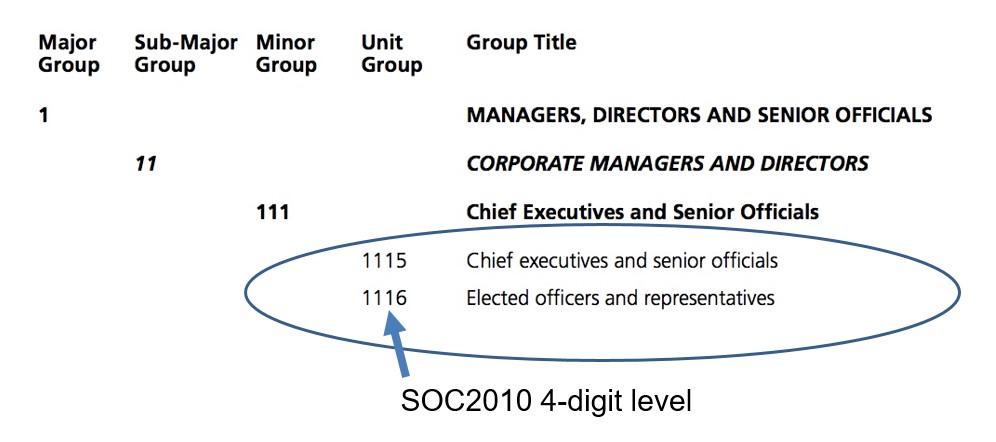Data documentation
This section provides detail on how the LMI for All database is structure, as well as the contextual information, datasets and indicators.
A summary of these sources are available here and LMI for All Data overview (February 2019) is also available.
LMI for All organising framework
Data are linked together by occupation classified at the unit group 4-digit level of the 2010 Standard Occupational Classification (SOC) produced by the Office for National Statistics. An index of around 28,000 job titles mapped to SOC enables the end-user to search for and access data of interest and relevance to careers in an intuitive fashion. The SOC2010 structure provides an organising framework for LMI for All. The following is an example of how the classification is structured:

More details on the methodology, structure and descriptions are available online:
- Volume 1 outlines the background, resources, concepts, and processes of the Standard Occupational Classification.
- Volume 2 consists of a detailed alphabetical index of job titles, giving both the SOC2000 and SOC2010 Unit Group to which each is assigned.
The database will adopt the SOC2020 structure and work is underway to progress this.
Contextual data
To support the organising framework of the LMI for All database contextual data is included from the Office for National Statistics and the US O*NET system mapped to UK Standard Occupational Classification. The datasets provide description of occupational role and common tasks associated with the role:
- Occupational descriptions from the ONS Standard Occupational Classification
- Skills, Knowledge, Abilities and Interests from the US O*NET system mapped to UK Standard Occupational Classification
Data descriptions and indicators
As new data is published the LMI for All database is regularly updated. The current version of the LMI for All database contains the following key data sets:
- Employment (past, current and future) and replacement demands from Working Futures (please note these were produced before the pandemic and reflect what the labour market may have looked like before the pandemic)
- Pay and earnings based on the Annual Survey of Hours and Earnings and the Labour Force Survey
- Hours based on the Annual Survey of Hours and Earnings
- Unemployment rates from the Labour Force Survey
- Vacancies (incidence and causes) from the Employer Skills Survey
- Geographic patterns of employment from the Census of Population
- Current vacancies available from the Department for Work and Pensions’ ‘Find a job’ API
- Higher education destinations data from HESA
Data update schedule
- Unemployment rates (updated annually in the Autumn)
- Higher education destinations (updated annually in the Spring)
- Working Futures dataset – occupational projections to 2027 (updated every 3-4 years)
- Index of ONS job titles and descriptions linked to SOC2010 (reviewed and updated throughout the year)
- Pay and Hours (updated annually in the Spring)
- Skills, Knowledge, Abilities and Interests (reviewed and updated throughout the year)
- Integration of updated apprenticeship vacancy data and new mapping (coming soon!)
- Update number of vacancies, hard-to-fill and skills shortages from ESS (updated every 3 years)
- Updated mapping from SOC to O*NET (reviewed and updated throughout the year)
- New vacancy dataset using web scraping techniques (updated monthly)
- New course dataset (updated monthly)
- Work on updating to SOC 2020 is in progress!
